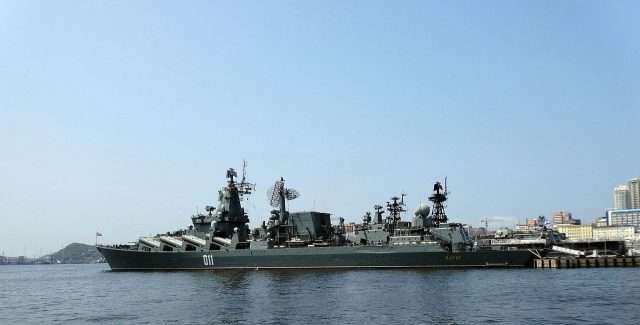
Geopolitical Report ISSN 2785-2598 Volume 19 Issue 15
Author: Riccardo Rossi
In an interview with the daily Krasnaya Zvezda on May 20th, 2022, Russian Navy Admiral Sergey Avakyants outlined a programme to deploy the Pacific submarine flotilla as the Kremlin’s response to the growing geopolitical instability in the Northwest Asia-Pacific region. In this area, the Russian Federation identifies the Sea of Japan and the Korean Peninsula as the main geostrategic areas.[1]
Geopolitical Scenario
In 2022, the Russian Federation will strengthen the Pacific fleet by deploying three types of submarine boats at the Petropavlovsk-Kamchatskiy submarine base.[2] The first is the Borei-A class ballistic missile launcher nuclear submarine (SSBN) Knyaz Oleg, equipped with 16 Bulava R-30 ballistic missiles, which, together with the TU-95 and TU-160 Blackjack long-range nuclear bombers and the strategic missile component (ICBM and IRBM) make up the «nuclear triad» of the Russian Federation. The remaining two submarines, deployed from Moscow to Petropavlovsk-Kamchatskiy, are a Yensen-class nuclear-guided missile submarine launcher (SSGN) Novosibirsk, and a diesel-electric propulsion unit of the Improved Kilo category, distinguished by its low noise footprint in navigation.[3]
The Putin presidency’s decision to reinforce the Pacific Fleet can be seen as the Kremlin’s response to the growing geopolitical instability in the northwest Asia-Pacific, aimed at pursuing a twofold geopolitical objective:
1) Supporting the shared strategy with the People’s Republic of China (PRC), aimed at backing the Kim-Jong-Un regime economically and militarily so that it can fulfil its function as a buffer state by separating the Russian-Chinese territories from the Republic of Korea and the U.S. military bases located in near Seoul and Japan.[4]
2) Supervising the Japanese-U.S. air-naval presence near the Straits of Korea and La Pérouse as obligatory passages for the Sea Lines of Communications (SLOC), which interconnect the Russian civil and military port network with the maritime trade routes passing through the East China Sea (ECS) and the Pacific Ocean.[5]
Among the SLOCs that cross the Sea of Japan, Moscow attaches particular political-economic importance to the Northern Sea Route (NSR), which, starting from the city of Vladivostok, crosses the narrows of La Pérouse, Bering and the waters of the Arctic Ocean, interconnecting the Asian and European markets.[6]
Over the past few years, the Putin presidency, faced with the steady increase in maritime traffic from the NSR from 7.3 million tonnes in 2016 to 31.5 million tonnes in 2019, has planned a medium- to long-term infrastructure investment plan in the main port cities touched by this route, three of which are Vladivostok.[7]
In drawing up this plan, the Kremlin evaluated the forecasts of various government institutions. These include the reports of the Ministry of Natural Resources (it assumed that 95 million tonnes of cargo would pass through the NSR by 2024), the Ministry of Transport (it predicted an increase of 35 million tonnes of cargo between 2023 and 2024) and the Federal Agency for Atomic Energy, which considered the volume of LNG through this route to increase by 41 million tonnes by 2024.[8]
Risk Assessment
The Russian Federation’s decision to increase the Pacific Fleet’s capabilities highlights the Kremlin’s necessity to protect its national interests due to the high geopolitical risk in the Northwest Asia-Pacific region. The Putin presidency has monitored the area because a possible conflict on the Korean peninsula between Pyongyang and Seoul would directly involve Moscow and Beijing. In this regard, Moscow has reached a strategic agreement with Beijing to supervise Kim-Jong-Un’s economic-military operations.
The second geopolitical danger grasped by the Kremlin relates to the possibility that in the event of a conflict in Korea, Washington, with the support of Tokyo and Seoul, would impose its own sea control near the Korean Straits, La Pérouse and Bering.[9] This would lead to a blockade of the North Sea Route, negatively affecting Moscow’s economy, especially the Russian energy companies (NorNickel, Gazprom, Lukoil, Novatek, Rosneft) that use the NSR to transport oil and gas to Asian and European markets.[10]
In addition to these heavy economic repercussions, it must be considered that a blockade of the NSR would have implications for the large cargo companies of many Asian countries (China, Japan, South Korea) that use this route to interconnect their economies with the European market.[11]
Sources
[1]Riccardo Rossi(2022), North Korea launched a ballistic missile from a submarine, SpecialEurasia, Retrieved from: https://www.specialeurasia.com/it/2022/05/09/north-korea-missile-asia-pacific/
[2] Riccardo Rossi (2022) Russian Federation’s militarisation of the Northwest Asia-Pacific, Geopolitical Report ISSN 2785-2598, Volume 18(1), SpecialEurasia. Retrieved from: https://www.specialeurasia.com/it/2022/04/09/russia-asia-pacific-military/
[3]Tass (2022) Two nuclear-powered subs to join Russia’s Pacific Fleet in 2022. Retrieved from: https://tass.com/defense/1453623
[4] Riccardo Rossi (2021) Geostrategy and military competition in the Korean Peninsula, Geopolitical Report ISSN 2785-2598, Vol 12 (10), Retrieved From: https://www.specialeurasia.com/it/2021/10/22/competition-korean-peninsula/
[5] Ibid
[6] Riccardo Rossi (2021) The Bering Strait, an area of Russian-US geostrategic interest, Geopolitical Report ISSN 2785-2598, Vol 16 (1). Retrieved From: https://www.specialeurasia.com/it/2022/02/07/bering-strait-russia-us/.
[7] D. F. Skripnuk, I. O. Iliyushchenko, S. V. Kulik, M Stepanova (2020)Analysis of the current state of the Northern Sea Route and the potential development of the icebreaker fleet, IOP Conference Series: Earth and Environmental Science.
[8]Statista, Cargo volume through the Northern Sea Route in Russia from 2019 to 2024, Retrieved From: https://www.statista.com/statistics/1063540/estimated-northern-sea-route-cargo-volume-by-source/
[9] Ibid
[10] D. F. Skripnuk, I. O. Iliyushchenko, S. V. Kulik, M Stepanova (2020)Analysis of the current state of the Northern Sea Route and the potential development of the icebreaker fleet, IOP Conference Series: Earth and Environmental Science.
[11] Ibid.



